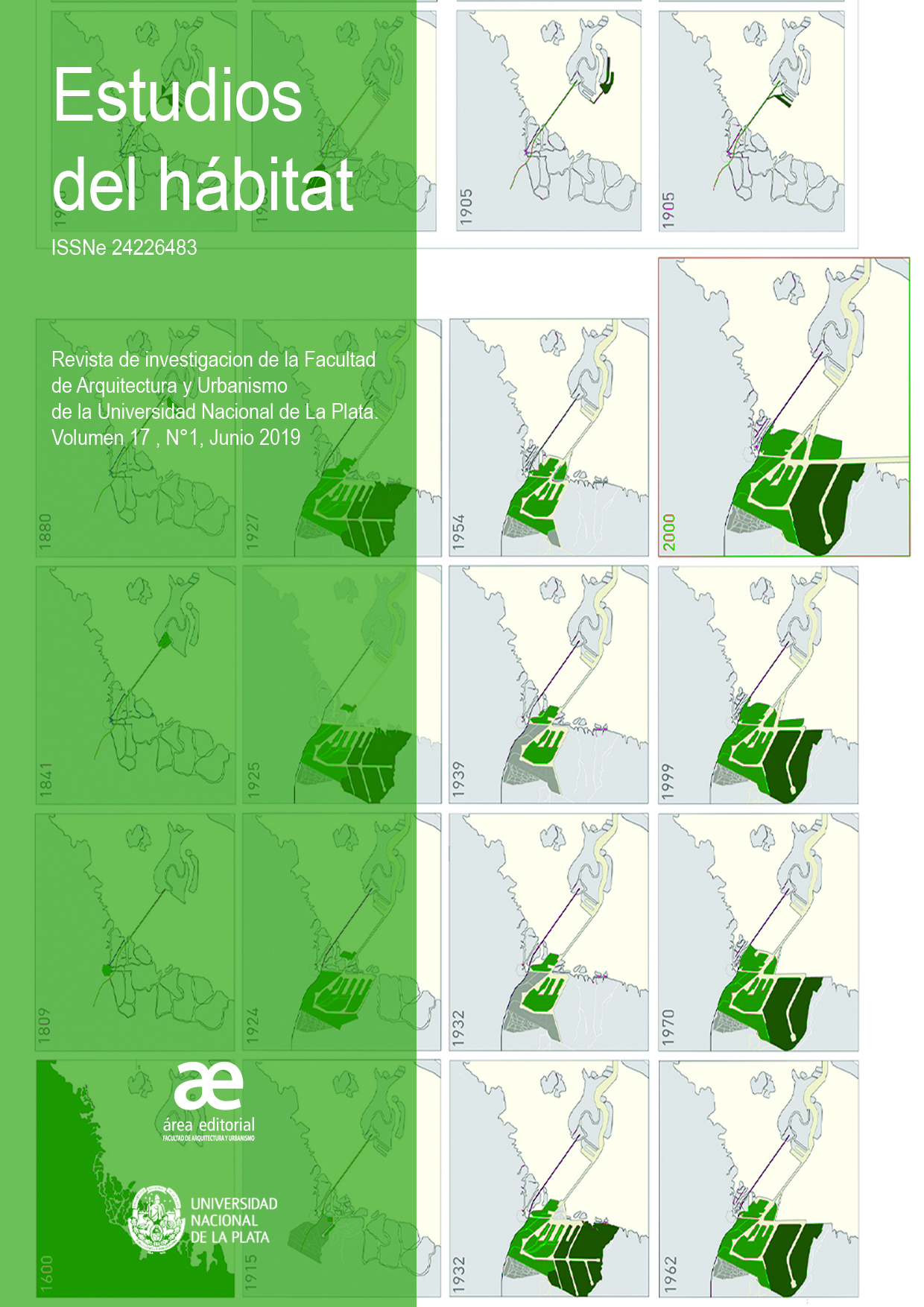Urban landscape, ecological infrastructure and temperature regulation
The case of Mar del Plata City, Argentina
DOI:
https://doi.org/10.24215/24226483e062Keywords:
Urban Landscape, Ecological infrastructure, Urban ecosystem services, Temperature regulation, ResilienceAbstract
Ecological infrastructure within urban landscapes delivers a wide range of ecosystem services that improves inhabitants well-being, one of which is the regulation of temperature. The knowledge of this service is a tool for developing planning strategies that improve resilience to the possible effects of global climate change. This paper proposes to analyze the spatial distribution of temperatures in the summer season and to explore the capacity of ecological infrastructure to provide the service of temperature regulation in Mar del Plata and its peri-urban. To this end, we consulted satellite information, and analyzed it with geographic information systems. The results indicate that there are differences in the distribution of temperatures between urban and peri-urban areas, which is due to the spatial heterogeneity of the urban landscape.
Downloads
Metrics
References
Adger, W. N. (2000). Social and ecological resilience : are they related ? Progress in Human Geography, 3, 347–364.
Antequera i Baiget, J. (2004). El potencial de sostenibilidad de los asentamientos humanos. Caixa de Sabadell.
Bayala, M. I., Rivas, R. E., & Scavuzzo, M. (2011). Generación de mapas de temperatura radiativa de superficie utilizando datos de baja resolución espacial mediante técnicas de remuestreo. Recuperado de: https://doi.org/10.1016/j.socscimed.2005.11.012
Bertrand G. (1975): “Pour une histoire écologique de la France rurale”, en Duby, G. y Wallon, A. (dirs.), Histoire de la France rurale, vol. 1, pp. 35-116
Civeira, G., Lado Liñares, M., Vidal Vázquez, E., & Paz González, A. (2018). Las áreas vegetadas en las ciudades y su aporte para mejorar la sustentabilidad ambiental. Perspectivas: Revista Científica de La Universidad de Belgrano, 1, 74–84. Recuperado de: https://revistas.ub.edu.ar/index.php/Perspectivas/article/view/9/8
EEA (European Enviroment Agency). (2011). Green infrastructure and territorial cohesion The concept of green infrastructure and its integration into policies using monitoring systems . Copenhagen.Ente Municipal de Turismo. (2018). Arribos de turistas 2007-2017. Recuperado de: https://datos.mardelplata.gov.ar/?q=dataset/arribos-de-turistas
Fernández García, F., & Rasilla Álvarez, D. (2008). Olas de calor e influencia urbana en Madrid y su área metropolitana. Estudios Geográficos, LXIX(265), 495–518. Recuperado de: https://doi.org/10.3989/estgeogr.0440
Ferraro, R., Zulaica, L., & Echechuri, H. (2013). Perspectivas de abordaje y caracterización del periurbano de Mar del Plata , Argentina. Revista Letras Verdes, 13, 19–40.
Folke, C., Carpenter, S., Elmqvist, T., Gunderson, L., & Walker, B. (2002). Resilience and Sustainable Development : Building Adaptive Capacity in a World of. Ambio, 31(5), 437–440.
Folke, C., Carpenter, S. R., Walker, B., Scheffer, M., & Chapin, T. (2010). Resilience Thinking : Integrating Resilience , Adaptability and. Ecology and Society, 15(4).
Gareis, M. C., & Ferraro, F. (2014). Actividad turística y emisiones de CO2. El caso de Mar del Plata. Revista de Estudios Ambientales, 2(1), 43–58.
Gareis, M. C., & Ferraro, R. (2017). Variación en el consumo energético en el partido de general pueyrredon entre los años 2010 y 2015. I+a - Investigación + Acción, 19, 27–40.
Gómez-Baggethun, E., Gren, Å., Barton, D. N., Langemeyer, J., McPhearson, T., O’Farrell, P., . . . Kremer, P. (2013). Chapter 11: Urban Ecosystem Services. En T. Elmqvist, M. Fragkias, J. Goodness, B. Guneralp, P. Marcotullio, R. Mc Donald, . . . C. Wilkinson, Urbanization, Biodiversity and Ecosystem Services: Challenges and Opportunities: A Global Assessment (págs. 175-251). Spriger.
Herrera, N., Skansi, M. de los M., Berón, M. Á., Campetella, C. M., Cejas, A., Chasco, J., … Suaya, M. (2018). Sistema de Alerta Temprana por Olas de Calor y Salud (SAT-OCS). Nota Técnica SMN 2018-50. Recuperado de: http://hdl.handle.net/20.500.12160/772
Holling, C. (1973). Resilience and Stability of Ecological Systems. Annual Review of Ecology and Systematics, 4(1973), 1–23.
Foster, J., Lowe, A., & Winkelman, S. (2011). The Value of Green Infrastructure for Urban Climate Adaptation. Washington, DC, USA: The Center for Clean Air Policy (CCAP).
INDEC (Instituto Nacional de Estadisticas y Censo). (2015). Estimaciones de población por sexo , departamento y año calendario (1st ed.). Ciudad Autónoma de Buenos Aires: Instituto Nacional de Estadística y Censos Estimaciones.
Jiménez-Muñoz, J., & Sobrino, J. (2003). A generalized single-channel method for retrieving land surface temperature from remote sensing data. Journal of Geophysical Research, 108, 2–9. Recuperado de: https://doi.org/10.1029/2003JD003480
Massone, H. E., & Martinez, D. E. (2017). Proyecto WATERCLIMA LAC 2015-2017. Compilación de informes técnicos producidos en el Área Piloto Mar del Plata. (Universidad Nacional de Mar del Plata, Ed.) (1st ed.). Mar del Plata.
MEA (Millennium Ecosystem Assessment). (2005). Ecosystems and Human Well Being (1st ed.). Washington: Island Press.
Norton, B. A., Coutts, A. M., Livesley, S. J., Harris, R. J., Hunter, A. M., & Williams, N. S. G. (2015). Landscape and Urban Planning Planning for cooler cities : A framework to prioritise green infrastructure to mitigate high temperatures in urban landscapes. Landscape and Urban Planning, 134, 127–138. Recuperado de: https://doi.org/10.1016/j.landurbplan.2014.10.018
Pérez González, M. E., García Rodríguez, M. P., & Guerra Zeballos, A. (2003). Análisis del clima urbano a partir de imágenes de satélite en el centro peninsular español. Anales de Geografía de La Universidad Complutense, 23, 187–206.
Pickett, S. T., Cadenasso, M. I., Grove, J. M., Boone, C. G., Groffman, P. M., Irwin, E., . . . Warren, P. (2011). Urban ecological systems: Scientific foundations and a decade of progress. Journal of Enviromental Management(92), 331-362.
Revi, A., Satterthwaite, F., Aragón-Durand, J., Corfee-Morlot, R., Kiunski, M., Pelling, D., . . . Solecki, W. (2014). Urban areas. En C. Field, V. Barros, D. Dokken, K. Mach, M. Mastrandrea, T. Bilir, . . . L. White, Climate Change 2014: Impacts, Adaptation, and Vulnerability. Part A: Global and Sectoral Aspects. Contribution of Working Group II to the Fifth Assessment Report of the Intergovernmental Panel on Climate Change (págs. 535-612). Cambridge, United Kingdom : Cambridge University Press.
Secretaria de Ambiente y Desarrollo Sustentable de la Nación. (2015). Tercera comunicación nacional ante la convencion marco de las naciones unidas sobre el cambio climatico (1st ed.). Ciudad Autonoma de Buenos Aires: Secretaria de Ambiente y Desarrollo Sustentable de la Nación. Recuperado de: https://doi.org/10.1017/CBO9781107415324.004
SMN (Servicio Meteorologico Nacional). (2019). Caracterización: Estadísticas de largo plazo. Recuperado de: https://www.smn.gob.ar/caracterizacion-estadisticas-de-largo-plazo
Tzoulas, K., Korpela, K., Venn, S., Yli-pelkonen, V., Ka, A., Niemela, J., & James, P. (2007). Promoting ecosystem and human health in urban areas using Green Infrastructure : A literature review. Landscape and Urban Planning, 81, 167–178. Recuperado de: https://doi.org/10.1016/j.landurbplan.2007.02.001
Walker, B., Holling, C. S., Carpenter, S. R., & Kinzig, A. (2004). Resilience , Adaptability and Transformability in Social – ecological Systems. Ecology and Society, 9(2).
Zulaica, L., & Ferraro, R. (2013). Lineamientos para el ordenamiento del periurbano de la ciudad de Mar del Plata (Argentina), a partir de la definición de sistemas territoriales. Geografía Em Questao, 06(1), 202–230.
Downloads
Published
How to Cite
Issue
Section
License
Acorde a estos términos, el material se puede compartir (copiar y redistribuir en cualquier medio o formato) y adaptar (remezclar, transformar y crear a partir del material otra obra), siempre que a) se cite la autoría y la fuente original de su publicación (revista y URL de la obra), b) no se use para fines comerciales y c) se mantengan los mismos términos de la licencia.








.jpg)

















